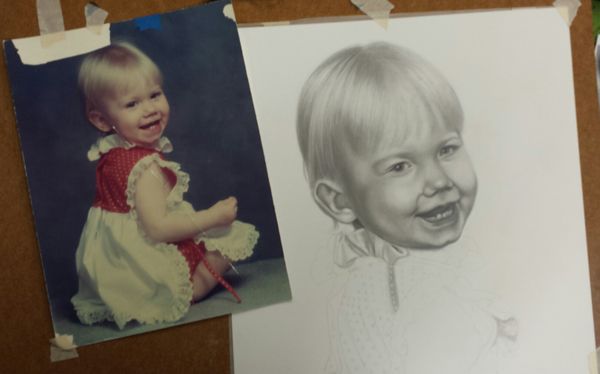How To Draw From A Reference
I of the well-nigh common statements I hear in my classroom is, "Something's non correct, Lee! Why does my drawing await "off?" Immediately, I'll have an thought of what the problem is, often before I even see the student's work. Sometimes it's because she has misjudged a shape while cartoon, merely mostly, she has an angle off and has drawn something out of alignment when referring to the photo reference.
Much of drawing is psychology. It'due south all nigh the way we call back, and how we perceive what we're looking at. It takes years to train the centre to see things accurately. Nosotros rely on our memories way as well much.

Nosotros accept clear definitions in our heed, stored much like a computer. When nosotros think of an center, for instance, instantly a preconceived image pops into our head. The same goes for all of the facial features. So as we depict, rather than really looking at our reference, nosotros have a trend to draw what we "think," instead of what we "see."
Our photo reference gives usa all the information we really demand. But often, we lack the focus to truly analyze it properly. What nosotros end up with in our cartoon is commonly a blended; a blend of what nosotros're actually looking at and what we're recalling from our minds.
Even when someone is focusing on their photo reference, I've found that the placement of their photograph is commonly all incorrect. Often information technology'll be off to the side, at a completely different bending than their artwork. So they look at the photo, then look abroad to piece of work on their art. Once more, they're drawing from retentiveness this way. At that place's no mode to be accurate doing this.
The solution for all of this is proper placement of your photo reference while you are drawing. Here are some adept tips to follow.
- Tilt your work. When drawing, it's very important to tilt your work towards you. Your confront and your cartoon paper should exist parallel one some other. This prevents whatsoever distortion. (This is why they created drafting and drawing tables that tilt towards you.) Yes, it may feel skilful to depict flat, similar nosotros did as kids, but that's what creates errors and distortions. Drawing flat elongates your work. It may wait bully flat, but tilt it towards you, and whoops! You lot may end up with a huge, stretched out forehead similar Herman Munster!
- Go on your photograph close. Tape your photograph right next to your artwork. This makes information technology easier to keep your eyes going back and forth from one to another for accuracy while you draw.
- Concentrate. As you are drawing, place your index finger on your photo, in the exact identify you lot're placing your pencil on your cartoon. Go slowly and motility your finger to match what you describe. This keeps your hand and eyes working together. You'll exist much more accurate this way.
- Apply straight lines to meet angles. Use a grid if you accept a hard time seeing angles. The straight vertical and horizontal lines of the grid will interruption down the shapes into increments, making the tilts and angles much easier to encounter. Sometimes just dividing your photo into 4 equal squares with one vertical and one horizontal line is enough to aid you see it properly.

- This is the about of import tip! Cheque your alignment! Be sure your photo AND your drawing are at the verbal same angle. Look at the references provided. This is 1 of my drawings in progress. In the first example, the photo is shut to the art, but it's NOT at the aforementioned angle every bit the drawing. Can you encounter how the tilt of the little girl does not lucifer? This will lead to inaccuracy as you draw.

In the 2nd example, the photo is straight upward and down, which matches the paper. Only the drawing itself is tilted more than to the left than the image in the photo. While subtle, this also will lead to inaccuracy.

The tertiary example is the correct way to draw. The photo has been tilted a flake more to the left to match the slight tilt of the drawing. If I had allowed the photograph to be viewed straight upwardly and down, information technology wouldn't have matched and the angles would be slightly off. These small inaccuracies pb to problems when it comes to capturing a likeness.
These are just a few of the tricks I utilise when I depict teach to keep students on rails. Yous'll be amazed at how only a lilliputian slice of tape and holding your photo in the right place can help make your work ameliorate in a big way!
Hope that helps!
Lee
Lee Hammond has been called the Queen of Drawing. That may not exist fair these days since, in addition to providing the best drawing lessons, she has as well created fantastic books and videos filled with the same easy to follow acrylic painting techniques, colored pencil techniques and more. Click hither to see all of the instructional books and DVDs that Lee Hammond has to offer!
Source: https://www.artistsnetwork.com/art-mediums/drawing/how-to-view-your-photo-reference-for-accurate-drawings/
Posted by: brenneraltaid.blogspot.com


0 Response to "How To Draw From A Reference"
Post a Comment